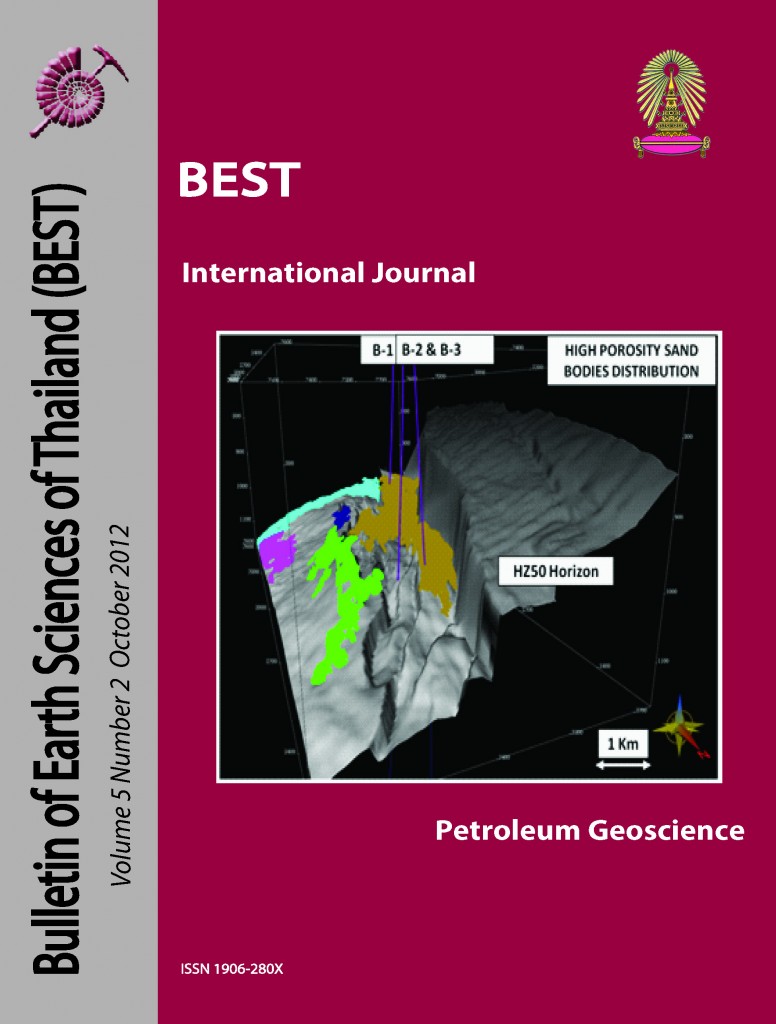Detection of Fluvial Sands Using Spectral Decomposition and Seismic Attributes in North Erawan Field, Pattani Basin, Gulf of Thailand
Main Article Content
Abstract
Pattani Basin is one of the major hydrocarbon producing areas of the Gulf of Thailand. The reservoirs in the Pattani basin are Lower to Middle Miocene fluvial channels and overbank sands. These reservoirs are sometimes thin and have restricted lateral distribution and it is not always possible to predict the distribution of these sands. This study attempts to predict sand distribution by applying advanced imaging techniques. Spectral decomposition out puts through Continuous Wavelet Transform (CWT) reveal that thicker sands (>30m) can be detected by amplitude spectra at 20 Hz, while relatively thin beds can be detected by higher frequencies. Bright amplitudes were observed at 20 Hz for hydrocarbon bearing zones. At shallow stratigraphic levels, RMS and coherency volumes successfully identified sand bodies and mud filled channels associated with meander belts. On the other hand, using 20 Hz CWT and coherency volumes can image deeper stratigraphic levels. These images show distribution of sands and mud filled channels at different stratigraphic level. Mud filled channels may act as barrier and compartmentalize the reservoirs. Some sands are distributed within small area (200-300m) cross cut by low amplitude mud filled channels. Therefore, narrow well spacing is required to drain the hydrocarbons from these sands. Sand distribution model is prepared within the zone of interest. The width of channel belts varies from 200 m to 3 km. These meander belts are N-S or NW-SE oriented. The mapped sands based on seismic data are in match with GR log at drilled wells. This suggested workflow of sand prediction might help to reduce exploration risk.
Article Details

This work is licensed under a Creative Commons Attribution-NonCommercial-NoDerivatives 4.0 International License.
Copyright © 2008 Department of Geology, Faculty of Science, Chulalongkorn University. Parts of an article can be photocopied or reproduced without prior written permission from the author(s), but due acknowledgments should be stated or cited accordingly.
References
Castagna, J., Sun, S. and Siegfried, R., 2002, The use of spectral decomposition as a hydrocarbon. The Gas Technology Institute, Fusion Geophysical, and the OU Geophysical Reservoir Characterization Consortium. V. 8, no. 3, p. 24-26.
Miall, A.D., 1992, Alluvial deposits, in R.G. Walker and N.P. James, eds., Facies Models: Response to Sea Level Change: Geological Association of Canada, p. 119-142.
Morley, C. K. and Racey, A., 2011, Petroleum geology. In: M.F. Ridd, A.J. Barber & M.J. Crow (eds.) The Geology of Thailand, Geol. Soc., London, p. 223-271.
Nordfjord, S., Goff, J.A., Austin, J.A. Jr& Sommer field, C.K., 2005, Seismic geomorphology of buried channel systems on the New Jersey outer shelf: assessing past environ- mental conditions. Mar. Geol., 214, 339-364.
Posamentier H.W. and Kolla, V., 2003, Seismicgeomorphology and stratigraphy of depositional elements in deep-water settings. Journal of Sedimentary Research, VOL. 73, P. 367–388


